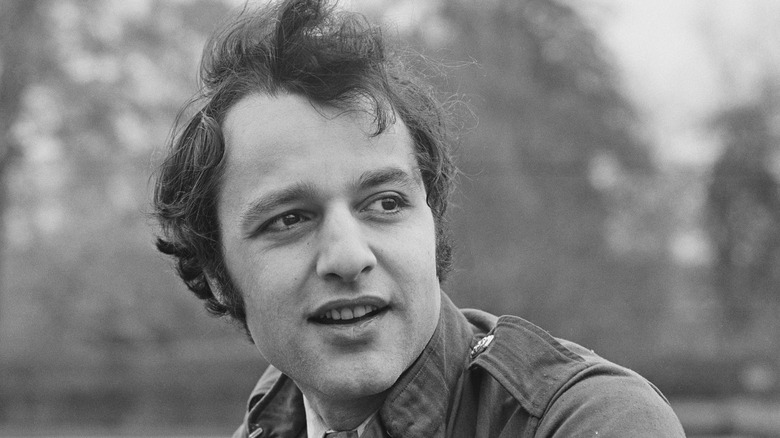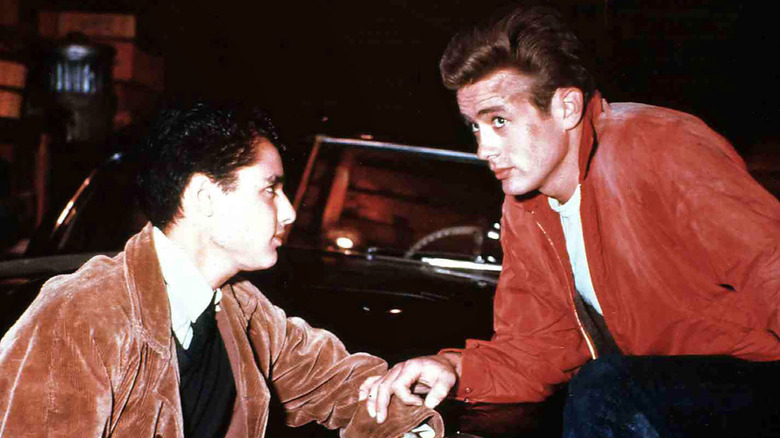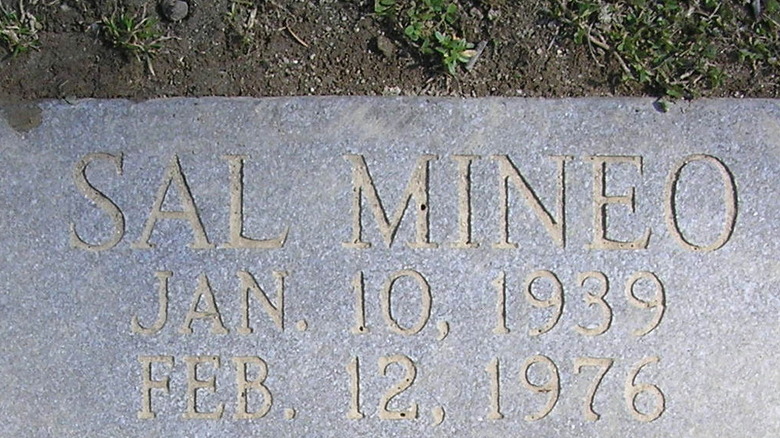The Tragic 1976 Murder Of Sal Mineo
The sudden shouts shattered the eerily quiet night on February 12, 1976. "Oh, no! Oh my God! No! Help me, please!" reverberated through the small apartment complex just off West Hollywood's Sunset Strip around 9:15, according to the Los Angeles Times. A neighbor ran out to see what the commotion was and found an Academy-Award nominated actor lying on his side in a quickly expanding pool of blood. "Sal, my God?" Ray Evans said as he turned Sal Mineo over and saw the gaping stab wound in his chest, per the Los Angeles Times. He tried mouth-to-mouth, but it was too late. Evans felt Mineo's last breath escape from his ashen face, and he was gone.
Sal Mineo had made a career out of playing young street toughs. His most famous role was in 1955s "Rebel Without A Cause," as John "Plato" Crawford, a troubled teen who bonds with James Dean's character, Jim Stark, per IMDb. On that night in February 1976, a real-life tough guy stabbed the 37-year-old actor to death and ran down a nearby alley. Initial reports said the suspect had long blond hair, per the Associated Press.
Sal Mineo's Career Had Stalled By the 1970s
By the winter of 1976, Sal Mineo's career had stalled. His stardom reached its zenith in the late 1950s and his last big role had been in 1964's "Cheyenne Autumn," according to The Vancouver Sun. The night someone brutally stabbed him to death, he'd been in rehearsals for a play, "P.S. Your Cat is Dead," that was about to begin at LA's Westwood Playhouse, per the Associated Press. The play was a far cry from the glamour of big Hollywood film productions. He had been in "Escape From Planet of the Apes" in 1971 but was basically unrecognizable under the ape suit, and there had also been guest appearances on some television shows, per The Vancouver Sun. But Mineo was just scraping by.
Sal Mineo was born in New York City in 1939 to Italian immigrant parents and grew up in the Bronx, where he got into some trouble before his mother set him on a path in the performing arts, according to his Biography. He appeared on Broadway as a child and made the jump to Hollywood while still a teen, per Biography. After "Rebel Without A Cause," for which he received an Oscar nod, Mineo had a string of successful films roles, including a second Academy Award nomination for 1960s "Exodus," per Biography. But the leading-man roles Mineo craved never came, according to The Vancouver Sun.
The LA Sheriff's Department Case Goes Nowhere
Sal Mineo was openly gay when being out in Hollywood was considered risky for an acting career, per Biography. The Los Angeles Sheriff's Department honed in on Mineo's sexuality and alleged drug use as possible motives for his killing, according to The Hollywood Reporter. The investigators combed through his life and interviewed the actor's Hollywood friends and his former lovers, and eventually excluded each one, per The Hollywood Reporter. The original description of the suspect as a blond turned out to be incorrect. The detectives revised the description to that of a white male with dark hair, possibly wearing a black leather jacket, per UPI. As for motive, they still had none. "We just don't know," a Sheriff's Department spokesperson told UPI at the time.
Meanwhile, back East, Sal Mineo was laid to rest. On February 17, 1976, Mineo's funeral took place in Mamaroneck, N.Y., amid a crowd of 250 mourners, many of them fans of the actor, per the Associated Press. Mineo had bought his parents a home in a quiet, upscale section of the Westchester County town, north of New York City, per the Associated Press. His family buried him in nearby Hawthorne. New York City Police detectives attended the funeral incognito, hoping to turn up leads, but nothing came of it, per The Hollywood Reporter.
A Break in the Sal Mineo Murder Case
Two weeks after Sal Mineo's murder, when the Los Angeles Police arrested a 19-year-old named Lionel Ray Williams on an unrelated robbery charge, he told investigators he'd heard Sal Mineo had been murdered during a drug deal gone wrong, according to Michael Gregg Michaud's 2010 book "Sal Mineo: A Biography." The police believed Williams' had made up the story to cover his own tracks, but when Williams' mother gave him an alibi, that angle went cold.
Finally, in May 1977, Williams' wife, Theresa Williams, told detectives her husband had murdered Mineo, per Sal Mineo: A Biography. When Williams returned home on the night of the killing, he was covered in blood, told her he stabbed a man, and later, when he saw a news story about Mineo, told Theresa, "that's the dude I killed," according to the book. The detectives hadn't initially believed it was a robbery since the victim's wallet hadn't been stolen, according to The Hollywood Reporter, but that's what it turned out to be. Williams had stabbed Mineo to shut him up and then ran off after getting nothing, per Michaud's book. The original suspect, described as being a white man with long blond hair, turned out to be a bystander who'd chased after the actual killer, per The Hollywood Reporter.
Lionel Ray Williams Goes On Trial
One major problem with the prosecution's case against Lionel Ray Williams was the eyewitness accounts that the suspect had been white with straight hair. Williams was Black and had an afro. But at the time of the murder, Williams, who was light-skinned, had been wearing his hair relaxed at the time, according to the Los Angeles Times. One defense witness at Williams' trial in early 1979 stuck to her story that Sal Mineo's killer was white. Monica Merrem, who was 9 at the time of the murder and saw the suspect run from the scene, told the jury "I noticed that he was very white because I could see the side of his face," per the Los Angeles Times.
The jury convicted Williams of second-degree murder for killing Sal Mineo and on 10 counts of robbery for a string of crimes from around the same time period as Mineo's murder, per The Hollywood Reporter. A judge sentenced Williams to a minimum of 51 years in prison. Williams' appeals were denied, per The Minneapolis Star. Mineo's senseless killing continues to haunt Hollywood, but the actor's roles still shine. "His arts, what he created, will always stand," his brother-in-law, Chip Meyers, said during Mineo's funeral, per the Santa Ana Register. "Nothing, not a person or the passage of time, can take it away from him."




